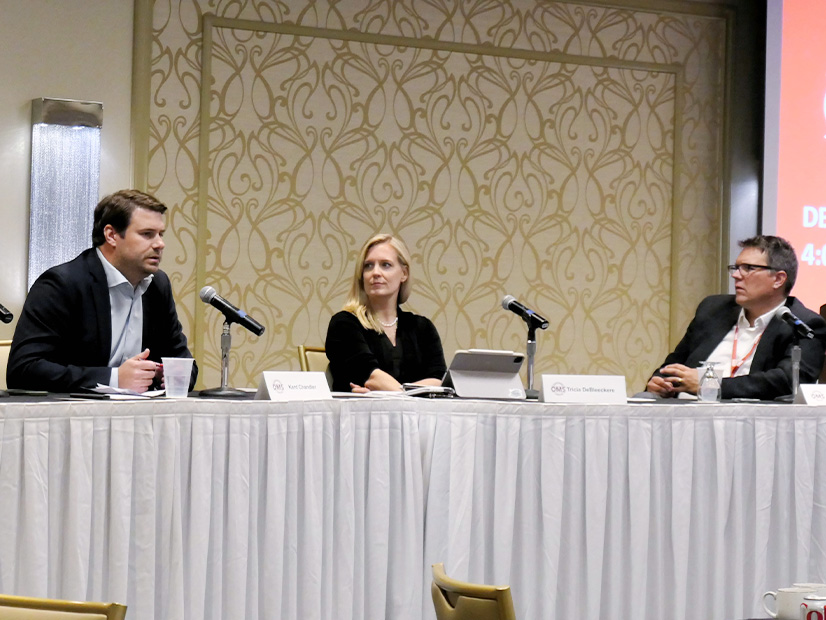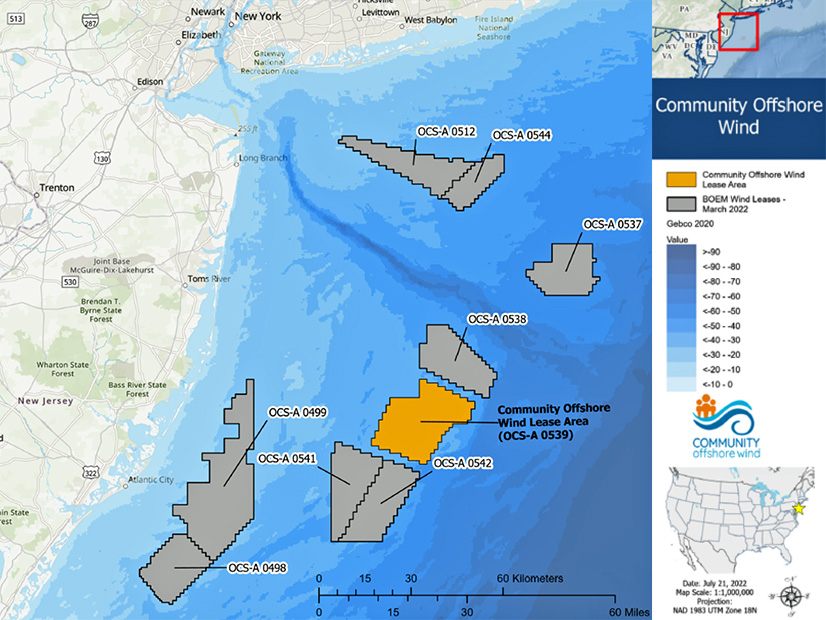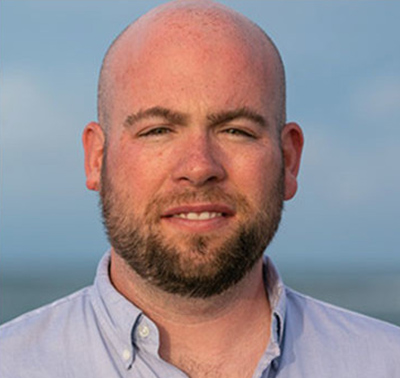COLUMBUS, Ohio — Uncertainty was the throughline across several panels on the state of PJM’s markets during the Organization of PJM States Inc. (OPSI) Annual Meeting, as state regulators, market participants and RTO officials discussed a possible delay in the 2026/27 Base Residual Auction (BRA) and debated the eightfold price spike in the prior auction.
PJM CEO Manu Asthana said that any time a change to auction rules or timelines is made, regardless of the merits, investor and consumer confidence in the outcomes can be damaged. Without certainty about price signals, he said the financing necessary to bring new resources to the markets can be impacted at a time when PJM projects resource adequacy shortfalls in the latter years of the decade. Balancing the need to deliver prices reasonable to consumers while sending price signals to invest could mean making hard decisions about what priorities the U.S. has in designing the future of the electric sector.
“I have a fear that without more explicitly choosing whether we’re going to actually relax some of our environmental goals; or if we’re going to relax our desire to win the AI race; or we’re going to be willing to pay higher prices; or we’re going to put all of our chips in to invent a new technology that comes up with this green and cheap power; that we will not actually have any of these things. We will not have a reliable grid; we will not have an affordable grid; and we may not be able to serve all of the data centers,” Asthana said.
In contrast to Asthana’s concerns about resource adequacy at the 2022 OPSI meeting, he said he’s more worried now about the confluence of permitting and supply chain challenges, accelerating load growth and increasing public policy pressure on generators. Developers considering building new gas-fired capacity in PJM have to weigh EPA regulations that require carbon capture and sequestration against the revenues that can be received through PJM’s markets.
“You’re seeing that in investment: If you look at what is coming through our queue, the picture is pretty dramatic. You saw gas plants, gas plants, gas plants; this year, almost no gas,” he said. “I’m not saying we only need gas; we need everything.”
To address resource adequacy concerns, Asthana said PJM seeks to make three key changes to how resources can come onto the grid: the process for transferring capacity interconnection rights (CIRs) from a deactivating generator to a new resource; surplus interconnection service (SIS) to allow new resources to be co-located at underutilized interconnections; and a reliability resource initiative (RRI) to create a one-time expedited application window for high capacity factor resources to be studied in Transitional Cycle 2.
The RRI concept has been met with criticism from many stakeholders who argue it would amount to preferential treatment for some resource classes at the expense of renewables that have been waiting years for interconnection studies to be completed. PJM has responded that new resources with a high reliability contribution are needed to ward off a potential capacity shortfall in the 2029/30 delivery year. (See Stakeholders Divided on PJM Proposal to Expedite High-capacity Generation.)
The Planning Committee endorsed a proposal from a coalition of stakeholders to create an expedited study process for resources receiving CIRs from deactivating generators during its Oct. 8 meeting. (See PJM Stakeholders Endorse Coalition Proposal on CIR Transfers.)
Elevate Renewables, the original sponsor of that package, told RTO Insider it is encouraged by PJM’s supportive statements during the OPSI meeting and the recognition that a process is needed to allow the efficient development of new resources in the place of retiring units.
“The replacement of existing resource should not be relegated to the back of a backlogged, multiyear-long interconnection queue process,” Elevate said in an email. “Instead, there are efficiencies gained by aligning the timing of the de-energizing of the deactivating resource with the energizing of the new replacement resource. However, the current state of the PJM queue creates a timing mismatch, which, as we’ve seen, has resulted in mass closures of generating facilities, affecting more than just reliability but employee and communities.”
Elevate said SIS presents PJM with an opportunity to optimize the capacity contribution of resources that are not fully using their maximum facility output. The RTO’s current rules prohibit any projects that would increase line flow or short circuit current from utilizing the SIS process to fast-track their interconnection.
“However, as currently deployed, the PJM [SIS] process creates significant roadblocks for battery storage and many other newer technologies and fuel types to utilize the process FERC directed all RTOs to adopt in Order 845,” Elevate said. “We are hopeful that as PJM makes statements that they plan to make tweaks to the surplus interconnection service process, that those tweaks would include changing the triggering criteria for project failure in the SIS process to be actual reliability criteria violations, e.g., line overload or breaker over duty as failing criteria.”
OPSI Speakers Discuss Future Auction Design
Speaking on a panel focused on the future of the capacity market, Executive Vice President of Market Services and Strategy Stu Bresler said PJM is working toward a Federal Power Act Section 205 filing in December to make several changes to the design of the BRA.
While the 2026/27 auction currently is scheduled to be conducted in December, PJM has asked FERC to delay its opening by six months (ER25-118).
The filing could include changes to how PJM models the output of generators operating on a reliability-must-run (RMR) contract, the topic of a complaint filed in September by the Sierra Club, Natural Resources Defense Council, Public Citizen, Sustainable FERC Project and the Union of Concerned Scientists that argues the expected output of RMR units should be included in the capacity market supply stack (EL24-148).
Bresler said PJM also is looking at changing the reference resource for the 2026/27 auction, which would be the first to use a combined cycle rather than combustion turbine as the model unit on which several parameters are based. Because of the higher energy and ancillary service revenues for combined cycle generators, the net cost of new entry (CONE) value fell to $0, bringing the Capacity Performance (CP) penalty rate for units that fail to deliver during emergency conditions to zero as well.
The disparity between the net and gross CONE also resulted in a significantly sharper variable resource requirement (VRR) curve capped at $696/MW-day should 145,774 MW or less clear the auction, falling to $0 at 149,455 MW.
“I think the reason why we went to [the Reliability Pricing Model] and the sloped demand curve in the first place is because we thought that the sort of boom-bust cycle associated with a more vertical demand curve was not the best answer for long-term lowest reasonable cost to the customer,” Bresler said. “And so getting back to a VRR curve and a slope of a VRR curve that results in a more stable pricing outcome given the supply and demand conditions I think is important.”
Vitol’s Jason Barker said a vertical demand curve with a narrow band of prices can create whiplash that undermines the auction’s value as a data point for investors evaluating PJM’s markets.
American Municipal Power Vice President of Transmission and Regulatory Affairs Steve Lieberman noted that the Members Committee had endorsed an AMP-sponsored proposal to redefine the penalty rate to be based on the BRA clearing price, a change that was rejected by the PJM Board of Managers. Complaints subsequently were brought by the Independent Market Monitor and East Kentucky Power Cooperative, both of which were rejected by the commission in August. (See PJM Board Rejects Lowering Capacity Performance Penalties.)
Because the bonus payments for overperforming during a performance assessment interval (PAI) are paid out of the pool of penalties collected under the CP construct, Lieberman said the status quo net CONE would eliminate the incentive to perform during an emergency.
Monitor Joe Bowring said RMR units are being retained to provide reliability services and thus should be included in the capacity market supply stack, which is one component of a package of changes to PJM’s generation deactivation rules proposed by the Monitor at the Deactivation Enhancements Senior Task Force. The results of an online vote on four proposals before the task force are set to be presented during its Nov. 14 meeting. (See PJM Stakeholders Delay Vote on Generator Deactivation Rules.)
The need to enter into RMR agreements constitutes a deeper market failure, Bowring said, driven by market rules that do not recognize the full reliability contribution of generators.
PJM has defended not including RMR units in the supply stack by arguing that those resources have a stated desire to leave the market, so a price signal is needed to incentivize development to replace them. It also has pointed to differing obligations for capacity resources, which are held to CP rules that penalize underperformance, and RMR agreements that limit when units can be deployed. Going beyond counting them in the supply stack to require that RMR units offer into the capacity market also would subject those units to PAI penalty risks, creating a disincentive for voluntarily entering into an RMR agreement.
Bresler noted that in some cases RMR agreements allowed PJM to dispatch those units only to resolve specific transmission security needs, which is something PJM may be rethinking. He cautioned that a one-size-fits-all approach likely does not make sense for a construct created to address specific transmission needs.
“No. 1, when it comes to RMR resources, I don’t think we want to include them or treat them or model them as supply in the auctions unless the service they’re providing is comparable to that of a capacity resource,” Bresler said. “Otherwise they’re not interchangeable, so you wouldn’t want to change the supply-and-demand balance on the basis of that assumption unless that’s the comparable service that they are providing.”
Barker expressed a similar outlook, stating that RMR units have different performance obligations from capacity resources and including the former in the supply stack could be unduly discriminatory if they are treated comparably to capacity without being held to CP standards.
Susan Bruce, representing the PJM Industrial Customer Coalition, said that the compressed auction schedule has left little time for developers to respond to the high price signals prompted by a generator leaving the capacity market to operate on an RMR contract. At the same time that consumers are paying higher capacity prices, they are also paying for transmission upgrades necessary to resolve the violations necessitating the RMR agreement, she said.
Gregory Poulos, executive director of the Consumer Advocates of the PJM States, said the repeated auction delays have led to risk being shifted to consumers, pointing to a “miscalculation” in the reliability requirement for the DPL South zone in the 2024/25 auction that cost consumers about $100 million in higher capacity costs with no corresponding reliability benefit.
It also left little time for market participants to respond to changes in the guidelines for energy efficiency resources offering into the following auction, which caused a marked drop in supply, Poulos said. A PJM filing at FERC would eliminate the resource class outright from the capacity market. (See PJM Asks FERC to Eliminate Energy Efficiency from Capacity Market.)
Given the little direct insight consumer advocates have on market decisions, they often are reliant on PJM estimates of the potential impacts market changes could have on prices, Poulos said. He urged PJM to use the information at its disposal to do more proactive modeling and analysis, which he said would improve consumer confidence in future auction outcomes.
More analysis and modeling of potential market changes could give stakeholders more certainty on proposals they are asked to vote on and increase certainty in future auction outcomes, he said.
Maryland Public Service Commissioner Michael T. Richard, moderator of the panel, said high prices can disrupt the economies and lives of ratepayers in PJM states.
“Markets are created for the customer. The concern I think some of us have is that after we see a sudden 800% jump in the market, we just have to ask, is this really a stable and predictable environment for customers, for state economies?” Richard said. “This essential service needs to be available to everybody and needs to be something that’s affordable.”
Panelists Discuss Price Surge in 2025/26 Auction
Speaking on a panel focused on the results of the 2025/26 BRA, Bresler defended the eightfold increase in prices, stating that the increase properly reflected tightening supply and demand. He said the capacity market has seen years of low prices owing to a surplus of generation in the market, leading to deactivations that are putting pressure on supply.
LS Power Senior Vice President of Wholesale Market Policy Marji Philips said the original concept of the capacity market was for prices to increase when demand is tight and fall when it is low, averaging out to net CONE over the lifespan of the reference resource. While regular market interventions have been creating price volatility and uncertainty, she said the return of prices to net CONE levels signals that investments in new generation are needed.
Bowring disagreed that the auction accurately reflected supply and demand, stating that administrative changes to the definition of capacity, namely the use of marginal effective load-carrying capability for resource accreditation, actually inflated prices. He also argued that supply is being suppressed by PJM’s categorical exemption of intermittent and storage resources from the requirement that all resources holding CIRs offer into the BRA. Both points were raised in the first two sections of the Monitor’s report on the 2025/26 auction. (See PJM Market Monitor Releases Second Section of 2025/26 Capacity Auction Report.)
“The design of the market did not reveal what the actual supply and demand was,” he said.
Clara Summers, campaign manager of the Consumers for a Better Grid project at the Illinois Citizens Utility Board, said there were changes in supply and demand, but they were not significant enough to account for the scale of the price jump seen in the July auction. Moreover, she argued that the capacity market is incapable of sending price signals to build because of the backlogged interconnection queue, an issue she said also is present when considering if high capacity prices can incentivize replacement resources while transmission upgrades are built.





